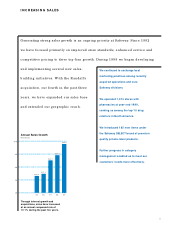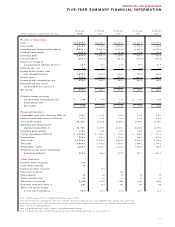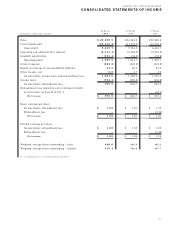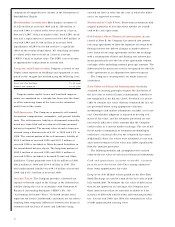Safeway 1999 Annual Report Download - page 22
Download and view the complete annual report
Please find page 22 of the 1999 Safeway annual report below. You can navigate through the pages in the report by either clicking on the pages listed below, or by using the keyword search tool below to find specific information within the annual report.
20
Cash flow from financing activities was $636.0 million in
1999 primarily due to borrowings related to the Randall’s and
Carrs Acquisitions. Cash flow from financing activities was
$903.4 million in 1998, reflecting borrowings related to the
Dominick’s Acquisition. Cash flow used by financing activities
was $614.6 million in 1997 primarily due to Safeway’s reduction
of total debt.
Net cash flow from operations as presented on the Statement
of Cash Flows is an important measure of cash generated by the
Company’s operating activities. Operating cash flow, as defined
below, is similar to net cash flow from operations because it
excludes certain non-cash items. However, operating cash flow
also excludes interest expense and income taxes. Management
believes that operating cash flow is relevant because it assists
investors in evaluating Safeway’s ability to service its debt by pro-
viding a commonly used measure of cash available to pay inter-
est. Operating cash flow also facilitates comparisons of Safeway’s
results of operations with companies having different capital
structures. Other companies may define operating cash flow dif-
ferently, and as a result, such measures may not be comparable to
Safeway’s operating cash flow. Safeway’s computation of operating
cash flow is as follows:
(Dollars in millions) 1999 1998 1997
Income before income taxes
and extraordinary loss $ 1,674 .0 $ 1,396.9 $1,076.3
LIFO expense (income) 1.2 7.1 (6.1)
Interest expense 362.2 235.0 241.2
Depreciation and amortization 695.6 531.4 455.8
Equity in earnings of
unconsolidated affiliates (34.5) (28.5) (34.9)
■■■■■■■■■■■■■■■■■■■■■
Operating cash flow $ 2,698.5 $ 2,141.9 $1,732.3
■■■■■■■■■■■■■■■■■■■■■
As a percent of sales 9.35% 8.75% 7.70%
■■■■■■■■■■■■■■■■■■■■■
As a multiple of
interest expense 7.45x 9.11x 7.18x
■■■■■■■■■■■■■■■■■■■■■
Total debt, including capital leases, increased to $6.96 billion
at year-end 1999 from $4.97 billion at year-end 1998 and $3.34
billion at year-end 1997, primarily due to the Randall’s, Carrs
and Dominick’s Acquisitions, the Vons Merger and the Safeway
stock repurchase. Annual debt maturities over the next five years
are set forth in Note C of the Company’s 1999 consolidated finan-
cial statements.
Based upon the current level of operations, Safeway believes
that operating cash flow and other sources of liquidity, including
borrowings under Safeway’s commercial paper program and bank
credit agreement, will be adequate to meet anticipated require-
ments for working capital, capital expenditures, interest payments
and scheduled principal payments for the foreseeable future.
There can be no assurance, however, that the Company’s business
will continue to generate cash flow at or above current levels. The
bank credit agreement is used primarily as a backup facility to
the commercial paper program.
Year 2000
In 1997, the Company established a year 2000 project group to
coordinate the Company’s year 2000 compliance efforts. Before
the end of calendar year 1999, the year 2000 project group deter-
mined what modifications or replacements to the computer-based
systems and applications were necessary to achieve compliance;
implemented the modifications; conducted the tests necessary to
verify that the modified systems were operational; and transi-
tioned the compliant systems into the Company’s regular opera-
tions. The Company also examined its relationships with key
outside vendors and others with whom the Company has signifi-
cant business relationships to determine, to the extent practical,
the degree of such parties’ year 2000 compliance.
The Company spent approximately $30 million, and Randall’s
spent $2.6 million prior to the acquisition, to address year 2000
issues, which included costs of modifications, testing and con-
sultants’ fees. The cost of the year 2000 compliance efforts were
funded from current operations and did not significantly impact
the Company’s operational decisions during the time the year
2000 issues were being addressed. The Company has not experi-
enced any material adverse effects on its liquidity or results of
operations relating to the year 2000 issues associated with its
systems or those of key outside vendors or others with whom the
Company has significant business relationships.
Forward-Looking Statements
This Annual Report contains certain forward-looking statements
within the meaning of Section 27A of the Securities Act
and Section 21E of the Exchange Act. Such statements relate to,
among other things, capital expenditures, acquisitions, operating
improvements, the effect of our share repurchase program on earn-
ings per share and cost reductions and are indicated by words or
phrases such as “continuing,” “on-going,” “expects,” and similar
words or phrases. The following factors are among the principal
factors that could cause actual results to differ materially from the
forward-looking statements: general business and economic condi-
tions in our operating regions, including the rate of inflation,
population, employment and job growth in our markets; pricing
pressures and competitive factors, which could include pricing
strategies, store openings and remodels; results of our programs to
reduce costs; the ability to integrate any companies we acquire
and achieve operating improvements at those companies; increas-
es in labor costs and relations with union bargaining units repre-
senting our employees; opportunities or acquisitions that we
pursue; and the availability and terms of financing. Consequently,
actual events and results may vary significantly from those includ-
ed in or contemplated or implied by such statements.
























